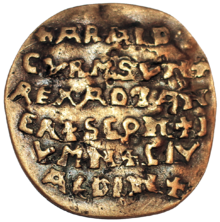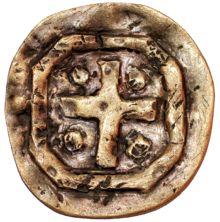
Birka, on the island of Björkö in present-day Sweden, was an important Viking Age trading center which handled goods from Scandinavia as well as many parts of the European continent and the Orient. Björkö is located in Lake Mälaren, 30 kilometers west of contemporary Stockholm, in the municipality of Ekerö.

Sweyn Forkbeard was King of Denmark from 986 until his death, King of England for five weeks from December 1013 until his death, and King of Norway from 999/1000 until 1013/14. He was the father of King Harald II of Denmark, King Cnut the Great, and Queen Estrid Svendsdatter.

Harald "Bluetooth" Gormsson was a king of Denmark and Norway.
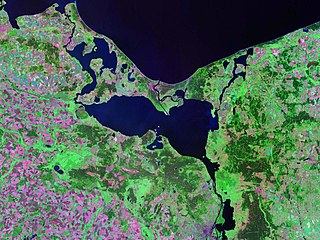
Wolin is a Polish island in the Baltic Sea, just off the Polish coast. Administratively, the island belongs to the West Pomeranian Voivodeship. Wolin is separated from the island of Usedom (Uznam) by the Strait of Świna, and from mainland Pomerania by the Strait of Dziwna. The island has an area of 265 km2 (102 sq mi) and its highest point is Mount Grzywacz at 116 m above sea level. The number of inhabitants is 30,000. Eastern suburbs of the city of Świnoujście extend to the Wolin island, while the towns of Międzyzdroje and Wolin lie further east.

Jomsborg or Jómsborg was a semi-legendary Viking stronghold at the southern coast of the Baltic Sea, that existed between the 960s and 1043. Its inhabitants were known as Jomsvikings. Jomsborg's exact location, or its existence, has not yet been established, though it is often maintained that Jomsborg was located on the eastern outlet of the Oder river. Historian Lauritz Weibull dismissed Jomsborg as a legend.

The Rök runestone is one of the most famous runestones, featuring the longest known runic inscription in stone. It can now be seen beside the church in Rök, Ödeshög Municipality, Östergötland, Sweden. It is considered the first piece of written Swedish literature and thus it marks the beginning of the history of Swedish literature.

The Jelling stones are massive carved runestones from the 10th century, found at the town of Jelling in Denmark. The older of the two Jelling stones was raised by King Gorm the Old in memory of his wife Thyra. The larger of the two stones was raised by King Gorm's son, Harald Bluetooth, in memory of his parents, celebrating his conquest of Denmark and Norway, and his conversion of the Danes to Christianity.
Thorgils Sprakalegg was a Danish nobleman whose children were active in the politics of Denmark and England in the early 11th century and who was grandfather of kings of both nations. Little is recorded about Thorgils in historical texts outside of his place in the genealogy of his children or grandchildren. Thorgils' cognomen Sprakalägg can be translated into English as "Break-leg" or "Strut-leg".
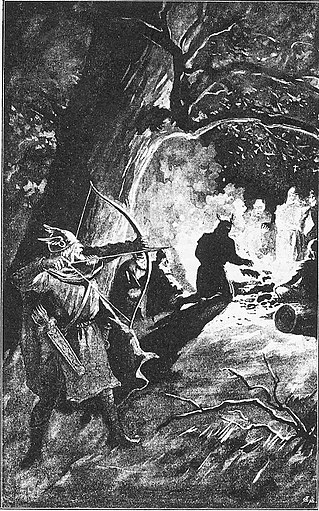
Palnatoke or Palnatoki, sometimes written Palna-Toki or Palna Toki, was a legendary Danish hero and chieftain of the island of Fyn. According to the Jómsvíkinga saga, Palnatoki founded the brotherhood of Jomsvikings and established its laws.
Haakon Sigurdsson, known as Haakon Jarl, was the de facto ruler of Norway from about 975 to 995. Sometimes he is styled as Haakon the Powerful, though the Ágrip and Historia Norwegiæ give the less flattering name Hákon Illi, that is, Haakon the Bad.
The Younger Futhark, also called Scandinavian runes, is a runic alphabet and a reduced form of the Elder Futhark, with only 16 characters, in use from about the 9th century, after a "transitional period" during the 7th and 8th centuries. The reduction, somewhat paradoxically, happened at the same time as phonetic changes that led to a greater number of different phonemes in the spoken language, when Proto-Norse evolved into Old Norse. Also, the writing custom avoided carving the same rune consecutively for the same sound, so the spoken distinction between long and short vowels was lost in writing. Thus, the language included distinct sounds and minimal pairs that were written the same.

The Jomsvikings were a legendary order of Viking mercenaries or conquerors of the 10th and 11th centuries. Though reputed to be staunchly dedicated to the worship of the Old Norse gods, they would allegedly fight for any lord who could pay their substantial fees, even if they may be Christian. The institution of the Jomsvikings would itself foreshadow those of the later religious and chivalric orders of the Middle Ages.
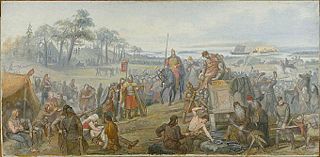
The Battle of Fýrisvellir was fought in the 980s on the plain called Fýrisvellir, where modern Uppsala is situated, between King Eric the Victorious and an invading force. According to Norse sagas, this force was led by his nephew Styrbjörn the Strong. Eric won the battle, and became known as "the Victorious".

The Battle of Hjǫrungavágr is a semi-legendary naval battle that took place in the late 10th century between the Jarls of Lade and a Danish invasion fleet led by the fabled Jomsvikings. This battle played an important role in the struggle by Haakon Sigurdsson to unite his rule over Norway. Traditionally, the battle has been set during the year 986, though the Gesta Wulinensis ecclesiae pontificum has the year 984 as the year of the battle.
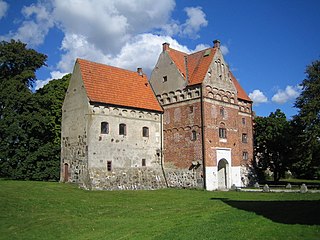
Borgeby Castle lies in Lomma Municipality, Scania in southern Sweden, beside the Kävlingeån, the largest river in Scania.
The Battle of Confey or Cenn Fuait was fought in Ireland in 917 between the Vikings of Dublin and the Irish King of Leinster, Augaire mac Ailella. It led to the recapture of Dublin by the Norse dynasty that had been expelled from the city fifteen years earlier by Augaire's predecessor, Cerball mac Muirecáin of Uí Fáeláin, and his ally Máel Finnia mac Flannacáin, the King of Brega.
Mstivoj was an Obodrite prince from 965 or 967 until his death. He inherited his position along with his brother Mstidrag from their father Nako in an unknown year.
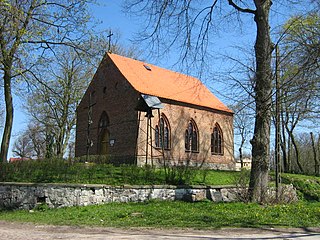
Wiejkowo, until 1945 named Groß Weckow, is a village in the administrative district of Gmina Wolin, within Kamień County, West Pomeranian Voivodeship, in north-western Poland. It lies approximately 6 kilometres (4 mi) south-east of Wolin, 19 km (12 mi) south of Kamień Pomorski, and 45 km (28 mi) north of the regional capital Szczecin. It is situated on the western shore of Ostrowo Lake in the historic region of Pomerania.

The nicknamed "Raven Penny", is a coin of the Viking Olaf Guthfrithson, minted during his reign as the king of York between 939–941.

Sven Gunnar Rosborn is a Swedish archaeologist, historian and writer best known for his contributions to the archaeology of the Viking Age in the province of Scania and for his leadership of archaeology and history research and education foundations. He has received media attention for the related to the Curmsun Disc, which he claims is a memorial plaque of the great Viking king Harald Bluetooth.
